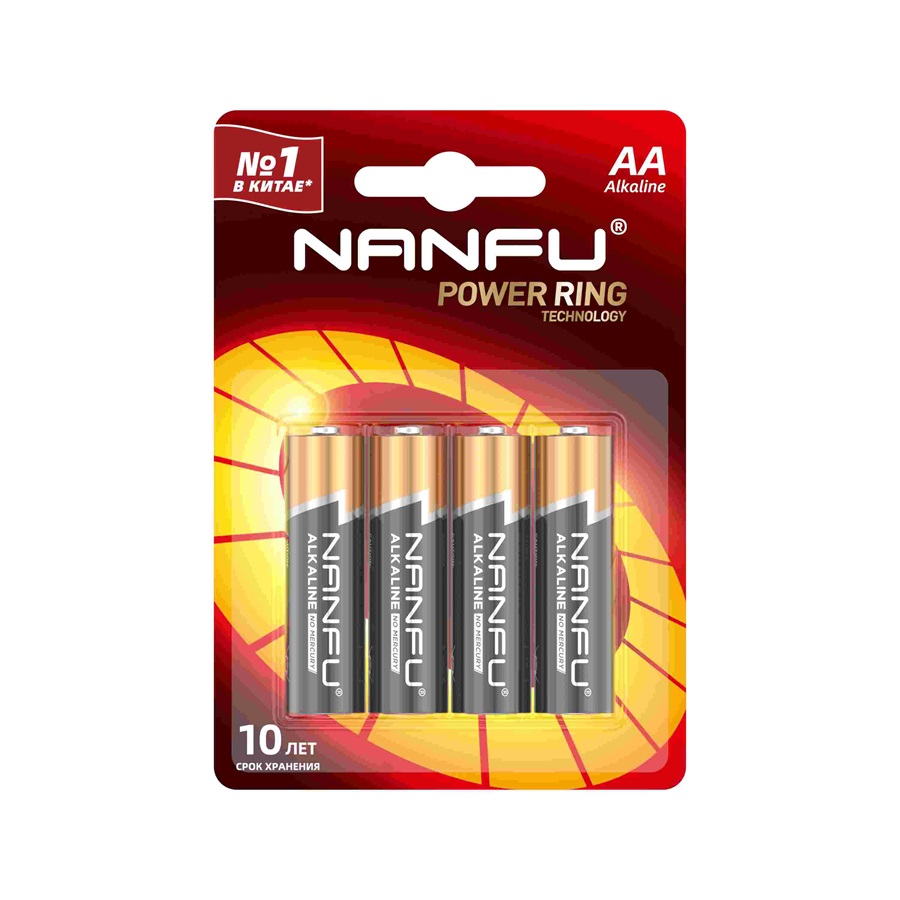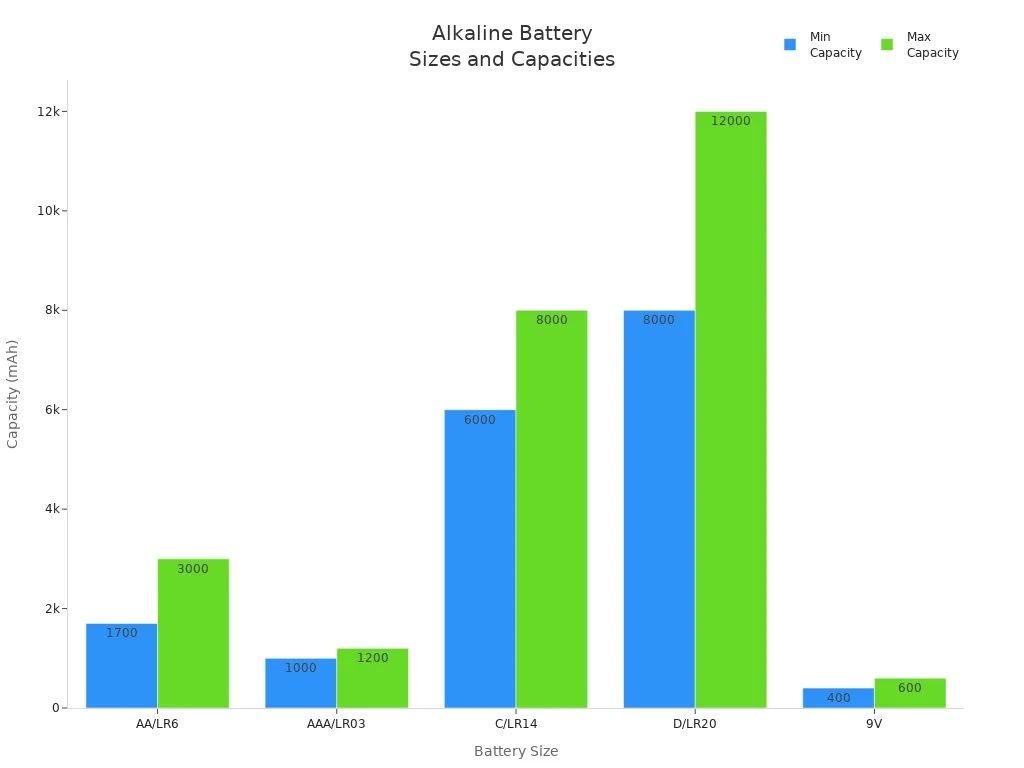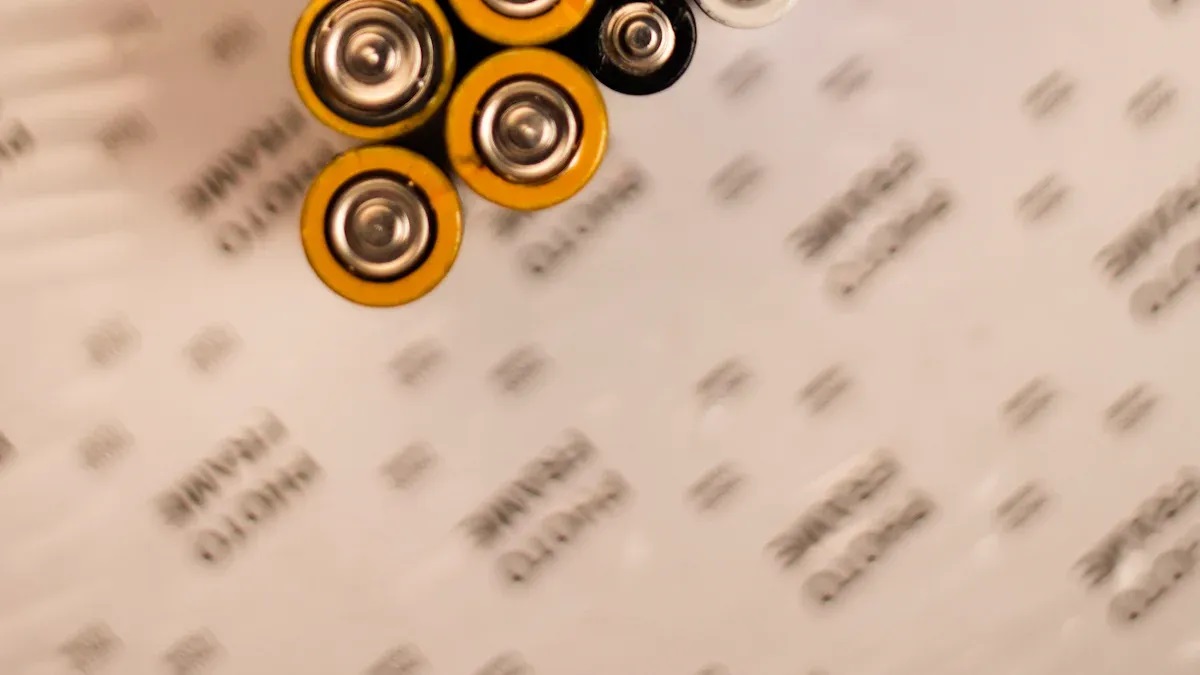Have you ever picked the wrong battery and your device stopped working fast? You should pick batteries that match your device’s power needs.
Choosing the right battery chemistry helps your device work well.
Devices that use lots of power need batteries with higher capacity.
Rechargeable batteries save money and are better for the environment.
Alkaline batteries usually work well for most everyday electronics.
Pick the correct battery size for your device. Pick the right chemistry too. This helps your device work well. Rechargeable batteries help you save money. They also make less trash. These are better for devices that use lots of power. Keep batteries in a cool and dry spot. Do not mix old batteries with new ones. This helps batteries last longer.

You see many battery sizes when you shop. It can be hard to know which one to buy. Here is a simple chart that shows the most common sizes and where you use them:
|
Battery Size |
Typical Capacity (mAh) |
Common Applications |
|---|---|---|
|
AA/LR6 |
1700 - 3000 |
Household devices, consumer electronics |
|
AAA/LR03 |
1000 - 1200 |
TV remotes, small toys |
|
C/LR14 |
6000 - 8000 |
High-drain devices |
|
D/LR20 |
8000 - 12000 |
Torches, portable stereos |
|
9V |
400 - 600 |
Smoke detectors, small electronics |

AA batteries are in things like cameras, toy cars, and speakers. AAA batteries are used in TV remotes, small flashlights, and wireless keyboards. C and D batteries are for things that need more power, like big flashlights or boomboxes. 9V batteries are often used in smoke detectors.
To help your device work well, you need the right battery size. First, check your device’s manual or look inside the battery compartment. Most devices tell you the battery size you need. Here is a quick chart to help you:
|
Key Considerations |
Description |
|---|---|
|
Battery Types and Sizes |
Manuals give the exact batteries you need. |
|
Voltage Specifications |
Knowing voltage helps your device work right. |
|
Recommended Battery Chemistry |
Some devices need a certain battery type. |
|
Special Handling Instructions |
Some batteries need special care. |
Tip: Most TV remotes use AAA batteries. Some old remotes use AA batteries. If you do not know, check the label inside the battery compartment.
When you use the right size, your alkaline batteries last longer and your devices work better.
Do you know why some batteries last longer in your flashlight? The answer is the mAh rating. mAh means milliampere-hour. It shows how much energy a battery can hold. A battery with a higher mAh rating lets your device run longer before changing batteries.
Alkaline batteries can give you three times more light in burst mode than in steady use.
If you use your flashlight or toy for short times, the battery works better than if you use it all the time.
Devices that need lots of power quickly make the battery run out faster. So, cameras and game controllers need batteries with higher mAh ratings.
Tip: For wireless keyboards or remotes, you can use batteries with lower mAh ratings. For flashlights or toys, pick higher mAh numbers for more playtime.
Voltage is just as important as how much power the battery holds. If you use the wrong voltage, your device might not work. Most home devices use batteries with 1.5V. Some bigger gadgets need 6V or 9V for more power.
|
Voltage |
Overview |
Applications |
Popular Products |
|---|---|---|---|
|
1.5V |
Used in most home devices |
Remotes, clocks, toys, flashlights |
Duracell Coppertop AA, Energizer MAX AAA |
|
6V |
Powers bigger devices |
Lanterns, garden lights |
Rayovac 6V Spring Top |
|
9V |
Gives more power |
Smoke detectors, guitar pedals |
Duracell 9 Volt, Energizer 9V |
Most devices work best when the battery is between 1.5V and 1.65V. When the voltage drops below 1V, your device will usually stop working. To keep your gadgets working well, always check the voltage in the manual or on the battery compartment.
Note: A battery at 1.3V is about halfway used. Change it soon to keep your device working well.

Single-use batteries are everywhere. You can find them in many stores. They are easy to use. Put them in your device and throw them away when done. But are they always the best for your device?
Let’s compare single-use alkaline batteries with rechargeable batteries. This is important for devices that use lots of power:
|
Feature |
Ni-MH Batteries |
|
|---|---|---|
|
Voltage Stability |
Starts at 1.5V, slowly drops |
Stays at 1.2V for a long time |
|
Power Delivery |
Good for high-drain |
Better for high-drain devices |
|
Discharge Curve |
Drops slowly, may show low battery warnings |
Stays steady until empty |
|
Battery Life |
Gets weaker over time, not always steady |
Stays strong, works well |
Single-use alkaline batteries are good for things like wall clocks or remotes. They last a long time on the shelf. You do not need to charge them. But in things like cameras or game controllers, they lose power fast. The voltage goes down as you use them. Your device might say “low battery” even if some power is left.
Tip: For emergency flashlights or smoke detectors, single-use alkaline batteries are best. They keep their charge for a long time. You do not need to check them often.
Rechargeable batteries, like Ni-MH, save money and help the earth. You can use them many times. You buy fewer batteries and throw away less trash. They cost more at first, but you spend less later.
Rechargeable batteries are great for things that use lots of power or get used every day. They give steady voltage and strong power until empty. You do not have to worry about power dropping suddenly.
Here is a simple chart to help you pick the right battery:
|
Device Type |
Recommended Battery Type |
|---|---|
|
Smoke Detectors |
Single-use Alkaline |
|
Remote Controls |
Single-use Alkaline |
|
Wall Clocks |
Single-use Alkaline |
|
High-Drain Devices |
Rechargeable |
|
Emergency Supplies (e.g., flashlights) |
Single-use Alkaline |
Use rechargeable batteries for things like wireless game controllers, cameras, or toys that need quick power. These batteries last longer and work better.
Note: Rechargeable batteries save you money over time. You buy them once and use them again. You also help the planet by throwing away fewer batteries.
You may wonder how batteries affect the earth. Studies show single-use batteries waste a lot of energy. In the U.S., people throw away AA batteries with $80 million of unused energy each year. Old batteries still have about 13% of their energy left. This means lots of power gets wasted. Rechargeable batteries help stop this waste and save energy.
The U.S. loses about 660 MWh of energy each year from unused AA alkaline batteries.
Thrown-away batteries still have energy, which leads to waste.
Using rechargeable batteries saves money and helps the earth.
Tip: If you want to help the planet, use rechargeable batteries for things you use often.
Have you ever found old batteries in a drawer and wondered if they work? Shelf life is important when you buy batteries for things you do not use every day. Most alkaline batteries last about 5 to 7 years. Some can last up to 10 years if you keep them in a cool, dry place. You can buy a lot at once and not worry about them going bad quickly.
Batteries with longer shelf life are best for emergency flashlights or smoke detectors.
Storing batteries the right way keeps them fresh for years.
Brands with longer shelf life are smart for things you use only sometimes.
Manufacturers put expiration dates on battery packs. This date shows how long the battery should keep at least 80% of its power if you store it right. After this date, batteries might still work, but they may not last as long or could leak.
|
Key Point |
Explanation |
|---|---|
|
Shelf Life Guarantee |
Batteries should keep at least 80% of their power until the expiration date. |
|
Risks of Expired Batteries |
Old batteries can run out faster, leak, or lose voltage. |
|
Degradation Factors |
Even if you store them well, batteries slowly lose power over time. |
Tip: Always use new, unexpired batteries in important devices. This helps stop leaks and keeps your gadgets safe.
Not all battery brands are the same. Some brands get better reviews because they last longer and work better. When you shop, you might see names like Energizer, Duracell, and Rayovac. These brands are often at the top in tests.
Energizer batteries are known for good performance and reliability. Many people like the Energizer Max line.
Duracell batteries are strong and have a long shelf life.
Rayovac Fusion batteries also get good reviews for lasting power.
Before you buy, check what other people say about the batteries. Look for reviews about how long the batteries last and if they leak. Some people have had problems with old batteries leaking and hurting their devices. Others think rechargeable batteries work better for things that use a lot of power.
Note: If you want to avoid leaks and device damage, pick a trusted brand and check the expiration date before you buy.
Do you use digital cameras, handheld games, or other gadgets that need a lot of power? Not all batteries can keep up with these high-drain devices. You need batteries that give steady power and last longer.
|
Brand |
Performance in High-Drain Devices |
Features |
|---|---|---|
|
Duracell |
Top performer |
Reliable power, designed to prevent leaks |
|
Energizer |
Top performer |
No Leaks Guarantee, long-lasting power |
When you pick batteries for high-drain devices, look for these features:
High battery capacity for longer use.
Good performance in hot or cold weather.
Strong durability for lots of use.
High-power output for tough gadgets.
Good build to stop leaks.
Some people see that alkaline batteries do not last as long in high-drain devices. If you use your camera or game console a lot, you might want to try lithium batteries or rechargeables. These choices give you more power and last longer.
Tip: For toys, cameras, or gaming devices, pick batteries made for high-drain use. Trusted brands usually work better and help protect your devices.
You want your batteries to last as long as possible, right? Good storage makes a big difference. Here are some easy tips to help you keep your batteries safe and ready to use:
Store batteries in a cool, dry place. Room temperature works best—between 59°F and 77°F.
Keep them away from metal objects. Metal can cause batteries to discharge or even short-circuit.
Leave batteries in their original packaging until you need them. This stops them from touching each other and losing power.
Don’t mix old and new batteries. Mixing can lead to leaks or damage.
Avoid high humidity. Moisture can cause corrosion and leaks.
Tip: Never store batteries in hot places like cars or near heaters. Heat can make the chemicals inside expand and leak.
You can get more out of your batteries with a few simple habits. Try these steps to make every battery count:
Always check the expiration date before using a battery.
Remove batteries from devices you don’t use often. This helps prevent leaks.
Use the right battery for your device. High-drain gadgets need stronger batteries.
Stick with trusted brands for better quality and longer life.
Clean up any leaks with isopropyl alcohol, not water.
If you follow these tips, your devices can run much longer. For example, using proper care, some batteries can last up to 10 years in storage.
|
Charging Cycles |
Estimated Lifespan |
|---|---|
|
300 |
2-3 years |
|
1,000 |
3-5 years |
|
15,000 |
10+ years |
When your batteries run out, don’t just toss them in the trash. Used batteries can harm the environment if you throw them away with regular garbage. Many stores and recycling centers accept old batteries. Look for a recycling symbol or ask your local waste center.
Note: Always tape the ends of used batteries before recycling. This helps prevent fires and keeps everyone safe.
Taking care of your alkaline batteries helps your devices work better and keeps the planet cleaner.
You can pick the best alkaline batteries by matching size and power to your device. Choose trusted brands like Duracell for high-drain gadgets. Store batteries in a cool place and never mix old with new. Want to share your battery tips or questions? Drop them in the comments below!